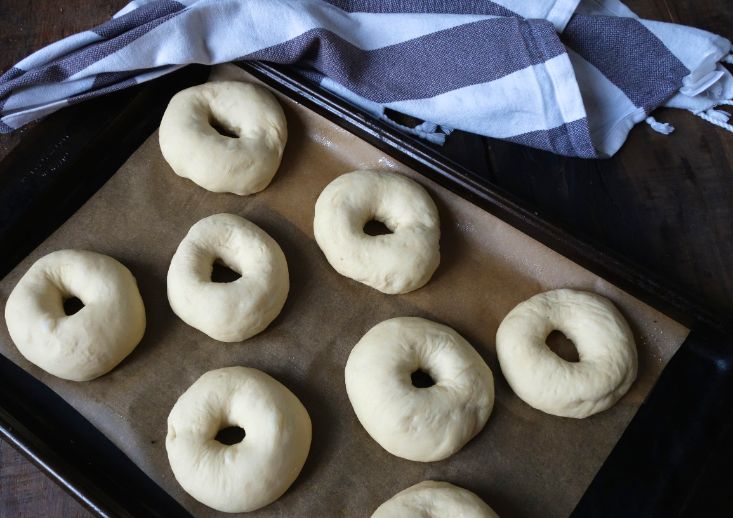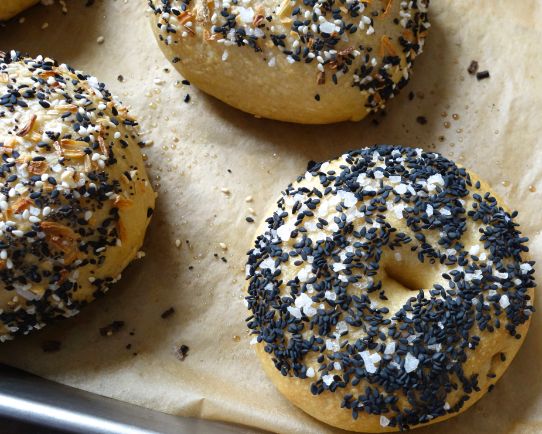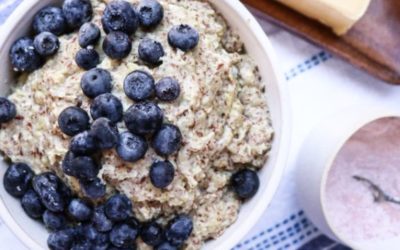This recipe was adapted from Smitten Kitchen, which she adapted from The Bread Baker’s Apprentice. These were such a treat to wake up to on a snowy February morning. It’s a two-day production but is well worth the effort. There is absolutely nothing like a bagel, covered in all your favorite toppings, that has just come out of the oven, and is slathered with butter… These put every other bagel you’ve ever had to shame.

Special equipment: stand mixer and dough hook
For the sponge:
- 1 teaspoon instant yeast (Also called “bread machine yeast”. I’m not sure if dry active will work here, as most of the recipes I looked through called for instant.)
- 4 cups unbleached bread flour (such as this)
- 2 ½ cups water, lukewarm
Stir the yeast into the flour in a 4-quart mixing bowl that fits into a stand mixer. Add the water, mixing until a smooth, tacky batter is formed. Cover with a damp kitchen towel and place in warm spot* for about 2 hours, until it has doubled in size. (*I use my oven. See this post for more information.)
For the dough:
- ½ teaspoon instant yeast
- 3 ¾ cups bread flour
- 2 ¾ teaspoons salt
- 1 tablespoon barley malt syrup
After it has risen, add the additional yeast to the sponge, stirring to incorporate. Add the additional flour, salt, and barley malt syrup. With the dough hook in place, mix on low speed in a stand mixer until the ingredients come together, slowly adding the remaining ¾ cup flour.
Increase the speed of the mixer, and continue to knead for another 6-10 minutes. The dough should be firm and smooth and should pass the windowpane test. If it rips easily, add a few drops of water. If it seems sticky, add a more flour, a tablespoon at a time.
Divide the dough into 16 equally sized pieces, (or more, for mini bagels), and form them into balls. Place, seam side down on lightly oiled, parchment lined baking sheets. Cover with a damp kitchen towel, and let rest for 20 minutes.
To each ball of dough, poke a hole with your finger through the middle, and gently pull it into an O of about 1 ½ – 2 inches. Being gentle is key here – be careful not to rip the dough. Place each bagel back on the oiled parchment, and mist or brush very lightly with an unflavored oil (such as canola). Cover loosely with plastic wrap, and let rest for another 20 minutes.
Use the float test to determine if the bagels are ready to be refrigerated. Drop one bagel in a bowl of room-temperature water. If it floats within 10 seconds, pat it dry, return it to the pan, cover the pan with plastic wrap and place in the refrigerator overnight or up to 2 days. If the bagel does not float within 10 seconds, return it to the pan, cover, let it continue to rest at room temperature, and reattempt the float test every 10-20 minutes.
The next day….
For the boiling:
- 1 tablespoon baking soda
- 3 tablespoons barley malt syrup
For the toppings:
- Sesame seeds
- Salt flakes
- Dried onion flakes
- Poppy seeds
- Cinnamon sugar
- Whatever your heart desires
Preheat the oven to 500 degrees. Fill a large dutch oven with water, the baking soda, and the barley malt syrup, and bring to a rolling boil.
Prepare your toppings. I made two variations: one “everything” with onion, salt, sesame, and poppy seeds and another of sesame seeds and salt flakes. Place your toppings on plates for easy dunking.
In batches, place the bagels in the boiling water, about one minute per side. After they’ve boiled, take each bagel and dunk it in your toppings. Place the bagels back on the oiled parchment.
Bake for approximately 5 minutes in the middle racks of the oven, then rotate the pans and bake for another approximate 5 minutes, or until the bagels are lightly browned.
Remove the pans from the oven, and let the bagels rest just until they’re cool enough to eat. Slather in butter or cream cheese, and enjoy!




